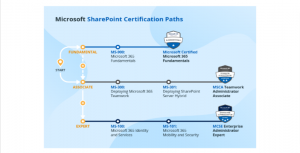Revenue Operations, or RevOps, is transforming how businesses drive growth. It aligns sales, marketing, and customer success teams. This alignment boosts efficiency and revenue.
RevOps is more than a buzzword. It's a strategic approach that breaks down silos. It fosters collaboration across departments.
Implementing RevOps best practices can be a game-changer. It helps businesses streamline processes and improve customer experiences. The result? Sustainable growth.
Data is at the heart of RevOps. It enables informed decision-making and performance tracking. This data-driven approach is crucial for success.
Technology also plays a vital role. Tools like CRM systems and automation platforms are essential. They enhance efficiency and coordination.
RevOps consulting firms offer expert guidance. They provide tailored solutions to optimize revenue operations. Their expertise can be invaluable.
This guide will explore RevOps strategies and best practices. It aims to help businesses achieve their revenue goals. Let's dive in.
What is RevOps? Understanding Revenue Operations
RevOps stands for Revenue Operations, a holistic approach to business growth. It integrates teams that traditionally operated in silos.
The primary goal of RevOps is to streamline operations. By aligning sales, marketing, and customer success, RevOps enhances collaboration.
Central to RevOps is its focus on data. Data analytics drives decision-making and operational efficiency. This focus ensures every team moves in sync.
RevOps offers numerous advantages:
- Improved Efficiency: Streamlines processes, reducing redundancy.
- Increased Revenue: Aligns efforts to boost sales.
- Enhanced Customer Experience: Offers consistent interactions across touchpoints.
Implementing RevOps can transform a company's growth trajectory. It cultivates a culture of continuous improvement and adaptability. This transformation is crucial in today's competitive market.
Why RevOps Matters: Key Benefits for Modern Businesses
RevOps is more than a buzzword; it's pivotal for modern business. By integrating departments, it creates a streamlined operation that boosts efficiency.
Businesses adopting RevOps enjoy several key advantages. Centralized data enables more informed decision-making. Teams can predict trends and respond swiftly.
RevOps enhances synergy between teams, fostering collaboration and innovation. This alignment leads to a more cohesive business strategy.
Key benefits of implementing RevOps include:
- Higher Revenue Growth: By aligning functions towards shared goals.
- Enhanced Customer Retention: Improving customer experience leads to loyalty.
- Reduced Operational Costs: Streamlining processes cuts unnecessary expenses.
Incorporating RevOps into a business's strategy can yield significant gains. These gains are crucial for staying competitive. Companies that embrace RevOps position themselves for long-term success.
Core RevOps Strategies for Success
Implementing RevOps strategies effectively demands a focus on key areas. These strategies are essential for optimizing operations and achieving business goals. Let's explore some vital strategies that can drive success.
Data Integration is at the core of effective RevOps. Merging data from sales, marketing, and customer success provides a comprehensive view. This unification empowers teams with actionable insights.
Process Automation plays a crucial role in optimizing efficiency. Automating repetitive tasks allows teams to focus on high-value activities. It reduces human error and accelerates operations.
Cross-Departmental Collaboration is essential for a seamless RevOps approach. Teams must break down silos and work towards a shared vision. This alignment ensures everyone is on the same page.
Implementing these strategies involves:
- Investing in Technology: Tools like CRM and marketing automation systems are indispensable.
- Regular Training Programs: These keep teams updated on new technologies and processes.
Furthermore, Customer-Centricity is pivotal for RevOps success. Tailoring strategies to customer needs enhances satisfaction and loyalty. This focus is key to driving long-term business growth.
RevOps strategies require continuous refinement and evaluation. Businesses must adapt to changing markets and internal dynamics. By doing so, they can maintain a competitive edge and ensure sustainability.
Building a High-Performing RevOps Team
Assembling a skilled RevOps team is crucial for implementing best practices. This team bridges gaps between departments and drives cohesive strategies. Key roles and skills are vital for a successful team.
Effective RevOps teams blend expertise in sales, marketing, and customer success. Each member brings unique insights for holistic strategies. Synergy between these experts ensures seamless operations.
Leadership within the RevOps team is paramount. A strong leader guides, coordinates, and aligns the team's efforts. They ensure goals and priorities are clear and achievable.
Consider these aspects when building your team:
- Diverse Skill Sets: Balance technical and strategic expertise.
- Strong Communication: Enable open dialogue across all departments.
- Continuous Learning: Encourage development through training and workshops.
Fostering a culture of collaboration and accountability is essential. This culture motivates team members to achieve goals and drive growth. Properly structured, a RevOps team can propel your business to new heights.
Aligning Sales, Marketing, and Customer Success
Alignment in revenue operations is pivotal for efficiency and growth. Sales, marketing, and customer success often work in silos, causing misalignment. RevOps breaks these silos, uniting them under a single strategy.
Collaboration among these departments results in a shared vision. Each team understands its role in achieving broader business goals. Unified efforts lead to improved customer journeys and satisfaction.
To achieve this alignment, consider these steps:
- Regular Cross-Department Meetings: Foster open communication and shared objectives.
- Integrated Strategies: Ensure marketing campaigns align with sales goals and customer success activities.
- Shared Metrics: Use common KPIs to evaluate performance across departments.
This alignment nurtures a seamless transition from lead generation to post-sale engagement. It ensures customers receive consistent messaging and support. Emphasizing collaboration reduces confusion and enhances productivity.
Ultimately, aligned teams create a strong framework for RevOps success. This synergy facilitates smoother operations and boosts revenue growth.
Data-Driven Decision Making in RevOps
In RevOps, leveraging data is crucial for success. With a clear focus on metrics, teams can make informed decisions. Data provides insights into performance, guiding strategic adjustments.
RevOps relies on data integration across departments to create a holistic view. This integration helps identify trends and opportunities. Teams can optimize strategies based on real-time data.
Key components of data-driven decisions include:
- Data Analytics: Analyze data to track performance and identify patterns.
- Performance Metrics: Use KPIs to measure success and drive improvements.
- Regular Data Audits: Ensure data accuracy and consistency across systems.
Data-driven strategies empower teams to act swiftly and confidently. By understanding customer behavior, teams can tailor their approaches. This results in enhanced customer experiences and satisfaction.
Ultimately, data-driven decision making boosts revenue operations' efficiency. It allows businesses to stay competitive and adaptable. Accurate data is the foundation for successful RevOps strategies.
Technology and Automation: The RevOps Tech Stack
Technology is a key element of successful RevOps. The right tech stack streamlines operations and enhances team collaboration. Automation also reduces manual tasks, boosting efficiency and consistency.
RevOps teams utilize a variety of tools to support their operations. These tools facilitate communication, data management, and process automation. Key technologies include:
- CRM Systems: Centralize customer data for easy access and management.
- Marketing Automation Platforms: Streamline campaigns and track performance.
Automation is especially vital in RevOps for improving process efficiency. It enables teams to focus on strategic tasks rather than manual operations. Common automation solutions include:
- Workflow Automation Tools: Automate repetitive tasks and approval processes.
- Analytics Software: Provides real-time insights for data-driven decisions.
Integrating technology across departments fosters seamless collaboration. Teams stay aligned, and information flows freely. These systems ensure everyone is on the same page, enabling quicker decision-making.
Investing in the right technology is essential for RevOps success. It not only drives growth but also prepares businesses for future challenges. Leveraging technology and automation creates a resilient and adaptive business model.
Process Optimization and Standardization
Optimizing and standardizing processes are critical in RevOps. These methods ensure consistency across sales, marketing, and customer success. Streamlined processes reduce delays and enhance efficiency.
Standardization brings uniformity to operations. It simplifies training and fosters better communication among team members. By creating a clear roadmap, everyone can follow the same guidelines, reducing confusion.
To achieve effective process optimization, consider these steps:
- Identify Inefficiencies: Look for bottlenecks that hinder workflow.
- Implement Best Practices: Adopt proven strategies that enhance performance.
- Regularly Review Processes: Continually assess and refine methods for improvement.
Optimization is an ongoing process, not a one-time effort. Organizations must be willing to adapt and update their procedures. Continuous assessment allows businesses to stay ahead in a dynamic market.
A structured approach to process management saves time and resources. It ensures that operations are scalable and adaptable to growth. Ultimately, process optimization and standardization form a solid foundation for RevOps success.
Measuring Success: KPIs and Performance Metrics
Measuring success in RevOps is essential for continuous growth. Key Performance Indicators (KPIs) and performance metrics provide valuable insights. They help track progress toward revenue goals.
KPIs should align with your RevOps objectives. Choose metrics that reflect meaningful performance. Some essential KPIs include sales cycle length, lead conversion rate, and customer churn rate.
Here's a list of important performance metrics to consider:
- Revenue Growth Rate: Measure increases over time.
- Customer Acquisition Cost (CAC): Evaluate the expense of gaining new customers.
- Net Promoter Score (NPS): Gauge customer satisfaction and loyalty.
Regularly assess these metrics to identify trends. Use data to make informed decisions and improve strategies. Performance metrics guide businesses toward better revenue operations.
A focus on KPIs and metrics leads to data-driven decision-making. It enables teams to adjust strategies based on real-world results. This approach is vital for sustaining RevOps success over the long term.
Overcoming Common RevOps Challenges
RevOps implementation comes with its own set of challenges. Understanding and addressing these can facilitate smoother operations. Let's explore common hurdles and ways to overcome them.
Communication breakdowns across departments are a frequent issue. Establishing regular interdepartmental meetings can enhance transparency. Promote open channels for feedback and information sharing.
Data integration is another major challenge. Disconnected systems lead to inaccurate insights. Unify data sources through integrated platforms and regular data audits.
Here are specific strategies to tackle RevOps challenges:
- Improve Technology Alignment: Use compatible systems and tools.
- Streamline Processes: Regularly review and update workflows.
- Encourage Team Collaboration: Build a collaborative culture across all levels.
Lastly, resistance to change can impede progress. Offer training and foster a culture that embraces innovation. Encourage continuous improvement to ease transitions and drive success in RevOps efforts. This proactive approach can make a substantial difference.
The Role of RevOps Consulting Firms
RevOps consulting firms are pivotal for many businesses aiming to enhance their revenue operations. They provide expert insights and customized strategies tailored to specific needs.
These firms offer numerous services that can accelerate RevOps success. They assess current processes, recommend improvements, and help integrate the latest technologies. Their expertise helps avoid common pitfalls and streamline transitions.
Key services offered by RevOps consulting firms include:
- Process Evaluation: Analyze existing workflows for efficiency.
- Technology Integration: Implement and optimize suitable tech solutions.
- Performance Monitoring: Establish KPIs and assess ongoing results.
Partnering with a RevOps consulting firm can enable organizations to unlock their full revenue potential. They combine industry knowledge with practical experience, ensuring effective RevOps strategies. Ultimately, firms guide businesses towards achieving sustainable growth and aligning departments seamlessly.
Continuous Improvement: Training, Feedback, and Adaptation
Continuous improvement is vital for sustaining successful RevOps. Companies must prioritize training, feedback, and adaptation to remain competitive and efficient.
Training programs equip teams with the necessary skills to handle evolving tools and processes. These programs should be regular and inclusive, enhancing knowledge and fostering teamwork.
Feedback loops are essential for identifying areas needing improvement. They provide insights into workflow obstacles and employee satisfaction.
Key elements for continuous improvement include:
- Regular Training: Keep teams updated on the latest trends and tools.
- Feedback Mechanisms: Encourage open communication for process enhancement.
- Adaptation Strategies: Embrace agility to swiftly respond to change.
By focusing on these aspects, organizations can maintain agility and effectiveness. Continuous learning and iterative improvements ensure RevOps strategies remain aligned with business goals.
RevOps Best Practices Checklist
A solid RevOps strategy requires adherence to certain best practices. This checklist helps streamline operations and maximize revenue growth.
Begin by ensuring alignment across all departments. Clear communication fosters collaboration and eliminates silos.
Key practices to include are:
- Data Integration: Consolidate data for actionable insights.
- Process Automation: Reduce manual tasks to enhance efficiency.
- Sales and Marketing Alignment: Synchronize efforts for cohesive strategies.
- Customer-Centric Focus: Prioritize customer success for retention and loyalty.
Consistently review this checklist to identify improvement opportunities. Embedding these practices into your operations helps ensure sustained progress and success in RevOps initiatives.
Conclusion: Achieving Sustainable Revenue Growth with RevOps
Embracing RevOps unlocks sustainable revenue growth. This strategic approach aligns critical departments for maximum impact. With RevOps, businesses can integrate data, automate processes, and focus on customer success.
By adhering to RevOps best practices, companies improve operational efficiency and revenue potential. Remember, continuous improvement and adaptation are vital for long-term success. Start harnessing the power of RevOps today and propel your business towards new heights.






